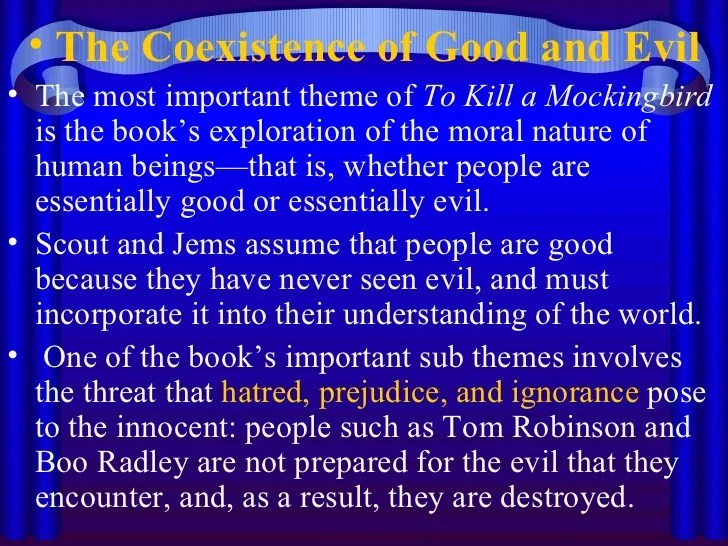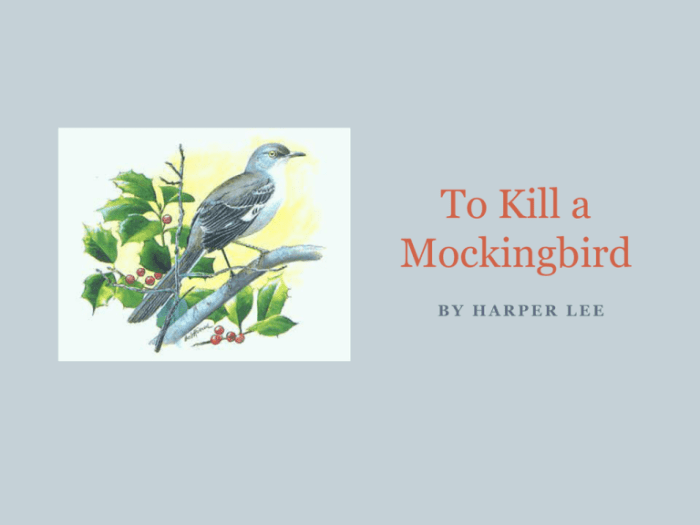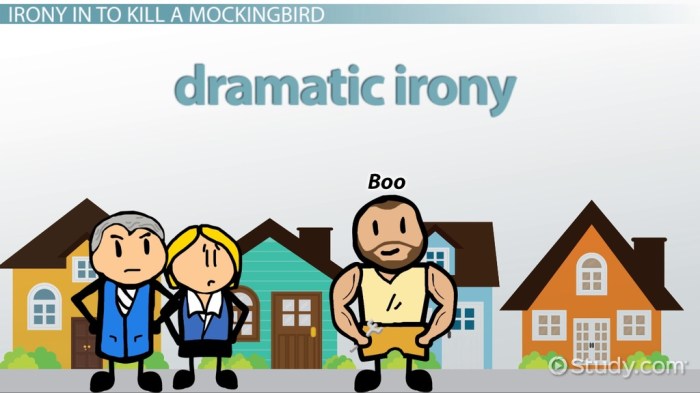To kill a mockingbird literary terms – In Harper Lee’s classic novel “To Kill a Mockingbird,” literary devices and themes intertwine to create a powerful and enduring work of fiction. This exploration delves into the intricate characterization, symbolism, narrative structure, and historical context that shape the novel’s profound impact on readers.
Characterization

In Harper Lee’s classic novel “To Kill a Mockingbird,” characterization plays a pivotal role in driving the narrative and exploring profound themes. The intricate portrayal of characters, their motivations, relationships, and development, enriches the story and invites readers to delve into the complexities of human nature.
The novel’s protagonist, Scout Finch, is a young girl who narrates the story. Her innocence, curiosity, and unwavering moral compass provide a unique perspective on the events that unfold. Through her eyes, readers witness the stark contrast between the idyllic summer days and the racial tensions that simmer beneath the surface of the Southern town of Maycomb.
Symbolism in Characterization
Lee employs symbolism to enhance the characterization of her protagonists. Scout’s tomboyish nature, for instance, symbolizes her rejection of societal norms and her determination to forge her own path. Her father, Atticus Finch, embodies the ideals of justice and integrity, serving as a moral compass for both Scout and the community.
Foreshadowing and Character Development
Foreshadowing plays a crucial role in the development of the characters. Early on, subtle hints are dropped about the impending trial of Tom Robinson, an African American man falsely accused of raping a white woman. These foreshadowing elements build suspense and create a sense of inevitability, as the characters navigate the complexities of the case.
Role of Setting in Shaping Characters
The setting of Maycomb, Alabama, during the 1930s, deeply influences the characters’ actions and beliefs. The stifling heat, the rigid social hierarchy, and the prevailing racial prejudices shape the characters’ perceptions and interactions. The novel explores the ways in which these external factors can both hinder and empower individuals.
Symbolism

Symbolism plays a pivotal role in “To Kill a Mockingbird,” enriching the novel’s themes, character development, and sense of place and time. Harper Lee employs various symbols throughout the narrative, each carrying profound meanings and contributing to the overall tapestry of the story.
One of the most prominent symbols in the novel is the mockingbird itself. Mockingbirds, known for their beautiful songs and harmless nature, represent innocence and the preservation of goodness in the face of adversity. The killing of a mockingbird symbolizes the destruction of innocence and the violation of justice.
The Boo Radley House
The enigmatic Boo Radley house serves as a symbol of fear, mystery, and the unknown. The house, shrouded in secrecy and surrounded by rumors, represents the hidden truths and prejudices that lurk within the community of Maycomb. As the story progresses, Boo Radley emerges from the shadows, revealing the kindness and compassion that lie beneath the surface of his misunderstood exterior.
The Courthouse
The courthouse, where the trial of Tom Robinson takes place, symbolizes the flawed justice system and the struggle for equality in the American South. The courtroom becomes a stage where the prejudices and biases of the community are laid bare, highlighting the challenges faced by those seeking justice in a society divided by race and social class.
Themes: To Kill A Mockingbird Literary Terms

Harper Lee’s “To Kill a Mockingbird” explores several profound themes that resonate deeply with readers of all ages. These themes are woven into the narrative through the experiences of the characters, the unfolding plot, and the evocative setting of the American South in the 1930s.
Racism and Prejudice, To kill a mockingbird literary terms
Racism and prejudice are central themes in the novel. The story unfolds in the racially segregated South, where African Americans face systemic discrimination and injustice. The trial of Tom Robinson, a black man falsely accused of raping a white woman, serves as a powerful indictment of the racist attitudes prevalent in the community.
The novel also explores the damaging effects of prejudice on individuals and society as a whole.
- Example:The character of Bob Ewell represents the epitome of racism and hatred, and his actions demonstrate the devastating consequences of prejudice.
- Example:The trial of Tom Robinson highlights the inherent bias and inequality within the justice system, exposing the ways in which racism can pervert the course of justice.
Loss of Innocence
Another significant theme in the novel is the loss of innocence. The protagonist, Scout Finch, experiences a profound transformation throughout the story as she witnesses firsthand the harsh realities of the adult world. The novel explores the complexities of growing up and the challenges of navigating a society marked by injustice and inequality.
- Example:Scout’s initial belief in the inherent goodness of people is shattered as she encounters the prejudice and cruelty of the adult world.
- Example:The death of Tom Robinson forces Scout to confront the harsh realities of racism and the fragility of justice.
Narrative Structure
The narrative structure of “To Kill a Mockingbird” is highly complex and sophisticated, employing a range of techniques to create suspense, emotional impact, and a profound exploration of its themes.The novel is narrated in a non-linear fashion, with frequent use of flashbacks and foreshadowing.
This structure allows Harper Lee to reveal information gradually, building tension and suspense while providing insights into the characters and their motivations. The novel’s opening chapters introduce the main characters and establish the setting, while subsequent chapters gradually reveal the events leading up to the trial of Tom Robinson.
This structure creates a sense of anticipation and dread, as the reader becomes increasingly aware of the impending tragedy.The novel also employs multiple perspectives, with the story being told primarily through the eyes of Scout Finch. However, there are also sections narrated from the perspective of other characters, such as Atticus Finch and Boo Radley.
This use of multiple perspectives provides a more nuanced and comprehensive understanding of the events of the novel, as well as the motivations and experiences of the characters involved.The opening chapter of the novel is particularly significant, as it introduces the main characters and establishes the setting of the story.
The novel’s closing chapters are equally significant, as they provide a resolution to the main plot and offer a profound reflection on the themes of the novel.
Flashbacks
The use of flashbacks in “To Kill a Mockingbird” is a key narrative technique that allows Harper Lee to provide insights into the characters and their past experiences. These flashbacks help to explain the motivations of the characters and provide a deeper understanding of the events of the novel.
For example, the flashback to the Radley family’s history helps to explain Boo Radley’s isolation and his subsequent actions throughout the novel.
Foreshadowing
Harper Lee also uses foreshadowing throughout the novel to create a sense of anticipation and dread. For example, the description of the Radley Place as a “spooky old house” foreshadows the events that will take place there later in the novel.
Similarly, the description of Tom Robinson as a “big black man” foreshadows the racial prejudice that he will face.
Multiple Perspectives
The use of multiple perspectives in “To Kill a Mockingbird” allows Harper Lee to provide a more nuanced and comprehensive understanding of the events of the novel. The novel is primarily narrated from the perspective of Scout Finch, but there are also sections narrated from the perspective of other characters, such as Atticus Finch and Boo Radley.
This use of multiple perspectives helps to create a more well-rounded and believable portrayal of the characters and their motivations.
Significance of the Opening and Closing Chapters
The opening chapter of “To Kill a Mockingbird” is particularly significant, as it introduces the main characters and establishes the setting of the story. The novel’s closing chapters are equally significant, as they provide a resolution to the main plot and offer a profound reflection on the themes of the novel.The
opening chapter introduces Scout Finch, the novel’s protagonist, and her family. It also establishes the setting of the story, the small town of Maycomb, Alabama. The closing chapters provide a resolution to the main plot, which revolves around the trial of Tom Robinson.
They also offer a profound reflection on the themes of the novel, such as racism, prejudice, and the importance of justice.
Historical Context

To Kill a Mockingbirdwas written during a period of significant social and political change in the United States. The Jim Crow era, a system of racial segregation and discrimination, was prevalent in the South, and the Civil Rights Movement was gaining momentum.
The novel reflects the social and political issues of its time. It portrays the racism and prejudice that were rampant in the South, and it explores the complexities of race relations in a small town.
The Jim Crow Era
The Jim Crow era was a period of racial segregation and discrimination in the United States that lasted from the late 1800s to the mid-1960s. During this time, African Americans were subjected to a variety of laws and customs that enforced segregation in all aspects of life, including education, housing, transportation, and employment.
The Jim Crow era had a profound impact on the lives of African Americans. It limited their opportunities for education and employment, and it made them vulnerable to violence and discrimination. The Jim Crow era is a dark chapter in American history, and it is important to remember the struggles that African Americans faced during this time.
The Civil Rights Movement
The Civil Rights Movement was a period of social activism that sought to end racial segregation and discrimination in the United States. The movement began in the early 1950s and gained momentum throughout the 1960s. The Civil Rights Movement was led by a variety of organizations, including the National Association for the Advancement of Colored People (NAACP), the Southern Christian Leadership Conference (SCLC), and the Student Nonviolent Coordinating Committee (SNCC).
The Civil Rights Movement was successful in achieving a number of important victories, including the passage of the Civil Rights Act of 1964 and the Voting Rights Act of 1965. These laws outlawed racial discrimination in employment, housing, and education, and they gave African Americans the right to vote.
The Civil Rights Movement had a profound impact on American society. It helped to end racial segregation and discrimination, and it paved the way for greater equality for African Americans.
The Novel’s Themes and Characters
The novel’s themes and characters are influenced by its historical setting. The novel’s protagonist, Atticus Finch, is a white lawyer who defends a black man, Tom Robinson, who has been falsely accused of raping a white woman. The novel explores the themes of racism, prejudice, and the importance of justice.
The novel’s characters are also influenced by its historical setting. Atticus Finch is a complex character who is both a product of his time and a man of conscience. He is able to see the injustice of the Jim Crow era, and he is willing to stand up for what he believes in.
The novel’s other characters are also complex and well-developed. Scout Finch, Atticus’s daughter, is a young girl who is learning about the world around her. She is innocent and curious, but she is also aware of the racism that exists in her community.
Tom Robinson is a black man who is falsely accused of raping a white woman. He is a victim of racism and prejudice, and he is ultimately convicted of a crime that he did not commit.
The novel’s characters are all affected by the historical context in which they live. They are shaped by the racism and prejudice of the Jim Crow era, and they must find ways to cope with the challenges that they face.
Question & Answer Hub
What is the significance of the mockingbird in the novel?
The mockingbird symbolizes innocence, vulnerability, and the importance of protecting those who cannot defend themselves.
How does the setting of Maycomb, Alabama, contribute to the novel’s themes?
Maycomb’s racial tensions and social hierarchy reflect the larger issues of prejudice and inequality prevalent in the American South during the 1930s.